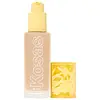Kosas Revealer Skin-Improving Foundation SPF 25 Versus Danessa Myricks Beauty Yummy Skin Serum Foundation
What's inside
What's inside
 Key Ingredients
Key Ingredients

 Benefits
Benefits

 Concerns
Concerns

 Ingredients Side-by-side
Ingredients Side-by-side

Zinc Oxide 7.5%
Cosmetic ColorantWater
Skin ConditioningEthylhexyl Olivate
Skin ConditioningOctyldodecanol
EmollientUndecane
EmollientPolyglyceryl-2 Dipolyhydroxystearate
Skin ConditioningGlycerin
HumectantMica
Cosmetic ColorantCalcium Sodium Borosilicate
Caprylic/Capric Triglyceride
MaskingNiacinamide
SmoothingPolyglyceryl-3 Diisostearate
EmulsifyingGalactoarabinan
Tridecane
PerfumingPropanediol
SolventCetyl Alcohol
EmollientGlyceryl Oleate
EmollientSodium Hyaluronate
HumectantPalmitoyl Tripeptide-5
Skin ConditioningPanthenol
Skin ConditioningSqualane
EmollientCaffeine
Skin ConditioningArnica Montana Flower Extract
MaskingArtemisia Capillaris Flower Extract
Skin ConditioningEthyl Ferulate
AntioxidantSodium Gluconate
Skin ConditioningPolyhydroxystearic Acid
EmulsifyingMaltodextrin
AbsorbentPentylene Glycol
Skin ConditioningLecithin
EmollientHydrogenated Lecithin
EmulsifyingTocopherol
AntioxidantPhenethyl Alcohol
MaskingCI 77891
Cosmetic ColorantIron Oxides
Zinc Oxide 7.5%, Water, Ethylhexyl Olivate, Octyldodecanol, Undecane, Polyglyceryl-2 Dipolyhydroxystearate, Glycerin, Mica, Calcium Sodium Borosilicate, Caprylic/Capric Triglyceride, Niacinamide, Polyglyceryl-3 Diisostearate, Galactoarabinan, Tridecane, Propanediol, Cetyl Alcohol, Glyceryl Oleate, Sodium Hyaluronate, Palmitoyl Tripeptide-5, Panthenol, Squalane, Caffeine, Arnica Montana Flower Extract, Artemisia Capillaris Flower Extract, Ethyl Ferulate, Sodium Gluconate, Polyhydroxystearic Acid, Maltodextrin, Pentylene Glycol, Lecithin, Hydrogenated Lecithin, Tocopherol, Phenethyl Alcohol, CI 77891, Iron Oxides
Hydrogenated Polyisobutene
EmollientEthylhexyl Palmitate
EmollientPhenyl Trimethicone
Skin ConditioningTridecyl Trimellitate
EmollientDiisostearyl Malate
EmollientSimmondsia Chinensis Seed Oil
EmollientSqualane
EmollientSilica Dimethyl Silylate
EmollientEthylene/Propylene/Styrene Copolymer
Isododecane
EmollientLinum Usitatissimum Seed Oil
PerfumingPassiflora Edulis Seed Oil
EmollientSalvia Hispanica Seed Oil
MoisturisingTocopheryl Acetate
AntioxidantHydrolyzed Sodium Hyaluronate
Skin ConditioningLimnanthes Alba Seed Oil
Skin ConditioningCurcuma Longa Root Oil
PerfumingCurcumin
AntioxidantZingiber Officinale Root Extract
MaskingBentonite
AbsorbentGlyceryl Behenate
EmollientAlcohol
AntimicrobialParfum
MaskingTitanium Dioxide
Cosmetic ColorantIron Oxides
CI 19140
Cosmetic ColorantHydrogenated Polyisobutene, Ethylhexyl Palmitate, Phenyl Trimethicone, Tridecyl Trimellitate, Diisostearyl Malate, Simmondsia Chinensis Seed Oil, Squalane, Silica Dimethyl Silylate, Ethylene/Propylene/Styrene Copolymer, Isododecane, Linum Usitatissimum Seed Oil, Passiflora Edulis Seed Oil, Salvia Hispanica Seed Oil, Tocopheryl Acetate, Hydrolyzed Sodium Hyaluronate, Limnanthes Alba Seed Oil, Curcuma Longa Root Oil, Curcumin, Zingiber Officinale Root Extract, Bentonite, Glyceryl Behenate, Alcohol, Parfum, Titanium Dioxide, Iron Oxides, CI 19140
Alternatives
Ingredients Explained
These ingredients are found in both products.
Ingredients higher up in an ingredient list are typically present in a larger amount.
Squalane is an emollient that helps the skin hold onto moisture. It's an oily liquid that occurs naturally in certain types of fish and plant oils.
Because squalane boosts hydration in the skin, it also comes with plenty of benefits: it is an antioxidant and can help fight free radicals and skin damage. Squalane is also found to have a detoxifying effect when applied.
Squalane comes from squalene, which occurs naturally within the sebum of our skin. It is one of the oils our skin produces to keep itself hydrated. Squalane is the hydrogenated version of squalene and has a longer shelf life.
Research shows that squalane is non-irritating (even at 100% concentration).
In general, it's a fantastic ingredient. It does a great job at hydrating the skin, and it's suitable for those with sensitive skin.
The source of squalane may impact malassezia / fungal acne. This is because olive oil derived squalane can contain impurities such as fatty acids and plant waxes. Sugarcane derived squalane is recommended for anyone with malassezia concerns.
Is squalane vegan?
This depends on the source. Squalane can be derived from both plants and animals. Most squalane used in skincare comes from plants.
Please note: the source of squalane is only known if disclosed by the brand. We recommend reaching out to the brand if you have any questions about their squalane.
Read more about squalene with an "e".
Is squalane an oil?
Squalane is often called an oil, but it’s technically not; it’s a hydrocarbon, meaning it’s only made of carbon and hydrogen, unlike true oils which are triglycerides made of fatty acids and glycerol.
The term “oil-free” isn’t regulated, so companies can define it however they want. Some exclude all oils, while others just avoid mineral oil or comedogenic oils.
While some people avoid oils thinking they cause breakouts, the right kind of oil (or oil-like ingredient like squalane) can actually help balance and hydrate your skin. It’s worth testing out simple oils or squalane to see what works best for your skin.
Learn more about SqualaneThis ingredient is a combination of red, black, and yellow iron oxide pigments. This combination of colors is usually found in foundation, because it results in a "skin" color.